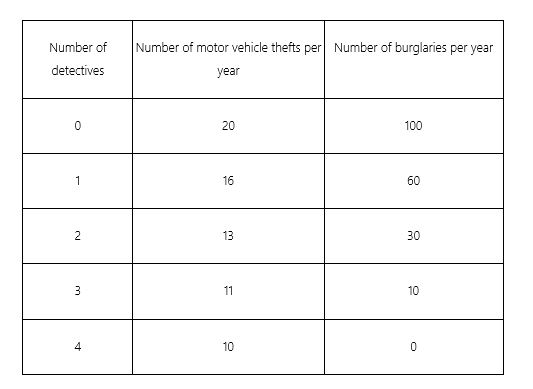Multiple Choice
Consider a police department trying to decide how to allocate its crime prevention resources between motor vehicle thefts and burglaries. The marginal benefit of one less motor vehicle theft is $20,000, and the marginal benefit of one less burglary is $1,000. Suppose the annual number of motor vehicle thefts and the annual number of burglaries depends on the number of detectives assigned to each type of crime, as shown in the table below. Each detective costs $35,000 each per year, regardless of whether the detective is assigned to motor vehicle thefts or burglaries.  What is the socially optimal number of detectives to be assigned to each type of crime?
What is the socially optimal number of detectives to be assigned to each type of crime?
A) 4 detectives to motor vehicle theft and 0 to burglary.
B) 3 detectives to motor vehicle theft and 1 to burglary.
C) 4 detectives to motor vehicle theft and 2 to burglary.
D) 0 detectives to motor vehicle theft and 4 to burglary.
Correct Answer:

Verified
Correct Answer:
Verified
Q56: Suppose there are three power-generating plants,
Q57: According to the textbook, as it is
Q58: Two firms, Industrio and Capitalista, have
Q62: In contrast to first-dollar insurance coverage, one
Q63: Suppose Matt and Gabe must both choose
Q64: Suppose there are three power-generating plants,
Q65: Suppose the figure below shows Luke's demand
Q66: Suppose that firms that had high rates
Q108: In the absence of environmental protection laws,
Q152: Compared to a fixed percentage reduction regulation,